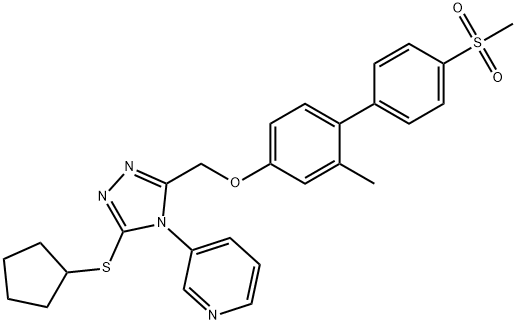The p97 AAA (ATPase associated with diverse cellular activities) is a ubiquitin-selective chaperone known to play a critical role in the degradation of misfolded membrane and secretory proteins and has been linked to various cellular processes that require unfolding and disassembly of protein complexes. Valosin-containing protein (VCP), also known as VCP/p97, is an AAA ATPase family member that serves as an integral component of the ubiquitin fusion degradation pathway and is overexpressed in many tumor types. NMS-873 is a VCP inhibitor (IC50 = 24 nM) that demonstrates potent selectivity for VCP/p97 compared to a panel of other AAA ATPases, Hsp90, and 53 additional analyzed kinases (IC50s >10 μM). It has been shown to inhibit the proliferation of HCT116 cancer cells with an IC50 value of 380 nM.
NMS-873 is a potent and specific VCP inhibitor, which has shown to activate the unfolded protein response, interfere with autophagy and induce cancer cell death.
NMS-873 is a selective allosteric non–ATP-competitive inhibitor of the AAA ATPase family member valosine containing protein (VCP), also known as p97 (VCP/p97), an integral component of the ubiquitin fusion degradation (UFD) pathway. VCP/p97 plays a role in degradation of misfolded proteins, Golgi membrane reassembly, membrane transport, myofibril assembly, autophagosome maturation, and cell division, and is overexpressed in many tumor types. NMS-873 is the most potent and specific VCP inhibitor described to date. NMS-873 has an IC50 of 30 nM for VCP/p97 compared to IC50 >10 μM against all of the AAA ATPases, HSP90 or the 53 kinases analyzed. NMS-873 inhibited proliferation of HCT116 cancer cell line cells with an IC50 value of 400 nM.
[1] magnaghi p, d'alessio r, valsasina b, avanzi n, rizzi s, asa d, gasparri f, cozzi l, cucchi u, orrenius c, polucci p, ballinari d, perrera c, leone a, cervi g, casale e, xiao y, wong c, anderson dj, galvani a, donati d, o'brien t, jackson pk, isacchi a. covalent and allosteric inhibitors of the atpase vcp/p97 induce cancer cell death. nat chem biol. 2013 sep;9(9):548-56. doi: 10.1038/nchembio.1313. epub 2013 jul 28.


